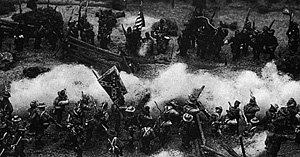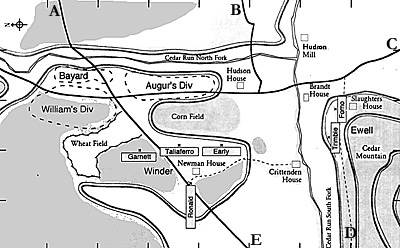
Rally brave men, and press forward! Your general will lead you.
Jackson
will lead you. Follow me!
--Thomas Jackson at the battle of Cedar Mountain
Historical Overview
The battle of Cedar Mountain was the first engagement in what would
become the Second Bull Run Campaign. Pope's "Army of the Virginia"
was moving south from the vicinity of Fredericksburg to support the
main Union Army in the Peninsula. General Lee dis patched Jackson
to strike Pope before the Union Army could con centrate and threaten
Richmond.
Jackson had three division of infantry numbering about 24,000 men.
Shortly after noon on 9 August, 1863, the Confederates bumped into
the advanced guard of Pope's army at Cedar Mountain. General Banks
commanded the advanced guard consisting of two infantry divisions
of the Union II Corps (about 9000 men).
The Confederates were slow to deploy and didn't get into position
until about 3 PM. Both army commanders seriously miscalculated the
strength of the opposing force. Jackson believed he faced a much larger
portion of Pope;s army than was actually on the field. Banks believed
he faced only the advanced guard of Jack son's corps. He also believed
he would receive support in his attack from the balance of Pope's
army, which was only a few miles away.
Banks attacked at 5 PM. Crawford's Union brigade overwhelmed and routed
portions of Ronald's Garnett's and Taliafero's brigades. Geary's Union
brigade also pushed the Confederate center back. At this point, the
Confederate Army was on the verge of total col lapse. However, Banks
had no reserves to exploit the success. Jackson desperately brought
reserves forward and rallied troops to stabilize the crumbling Rebel
line. A.P. Hill's division was committed brigade by brigade as fast
as they could reach the battlefield. Thomas' brigade stabilized the
Rebel right. Branch's brigade stopped Crawford's attack.
Eventually, overwhelming Con federate numbers began to force the Union Army back.
Hill then committed two more brigades and threatened the Union left.
All across the battlefield the Yankees were slowly and stubbornly
falling back. At one point, Crawford's brigade was almost surrounded
and trapped. The 1st Pennsylvania cavalry charged into the Rebels
to buy time. All but 71 of the 164 Union cavalrymen were killed or
wounded in the desperate charge. Finally, sometime between 6:30 PM
and 7PM, the Union line collapsed and gave up the fight. Both sides
had fought courageously, even if their commanders had mismanaged the
battle. The Confederates had 1,276 killed and wounded. General Banks,
the attacker, had 2,379 casualties (almost 30 percent of this corps).
Union Army
Maj. Gen. Nathaniel Banks (1 Corps Ldr)
II Corps Army of Virginia
Gen. Thomas Jackson (1 Corps Ldr)*
Left Wing, Army of Northern Virginia
STARTING POSITIONS: The scenario map indicates the historical dispositions
of the armies as of 5 P.M. when Banks began his attack. Both sides
must place their artillery in open ground to the south of the main
road between points A and B. Early's Brigade operates as independent
brigade from Ewell's Division.
Historically, Ewell had two batteries with him on Cedar Mountain (Bedford and Courtney Artillery). Most of A.P. Hill's artillery did not arrive at the battlefield in time
for the fight. Purcell's and Middlesex Artillery should be attached
Winder's Divi sional Artillery at the beginning of the game.
UNION REINFORCEMENTS: None
CONFEDERATE REINFORCEMENTS:
SPECIAL RULES:
Casualty points are accumulated as listed in the
Casualty Points Chart in Fire and Fury. The Union player also receives
10 points if they are able to capture and hold the Newman House for
at least one turn. The odds are against the Union Army in this battle.
To win, the Union commander will need to aggressively attack and hurt
the Confederate Army as must as possible in the first few turns and
then stubbornly defend. Eventually the overwhelming Confederate numbers
will force the Union Army off the field.
Decisive Victory: achieved a 3:2 ratio in victory points
Tactical Victory: accumulate more victory points than the oppos ing
side
Draw: both sides accumulate the same number of victory points
The War if the Rebellion: A Compilation of the Official Records of
the Union and Confederate Armies, 70 vols. in 128 parts (Washington
D.C. : Government Printing Office, 1880-1901), Series 1, Vol 12.
The Map
This article appears in MagWeb (Magazine Web) on the Internet World Wide Web. Jackson's lead division, commanded by General Ewell, secured Cedar
Mountain, the Confederate center and the Confederate right. Winders
division then secured the left flank. The Federals deployed their
left division in the open and hid their right division in the woods.
Unaware of the division hidden in the woods, Jackson only anticipated
action on his right. Winder positioned two if his brigades, one of
which was the Stonewall Brigade, to support the Rebel left. As a result,
their flank was exposed to the Union division hidden in the woods.
Jackson's lead division, commanded by General Ewell, secured Cedar
Mountain, the Confederate center and the Confederate right. Winders
division then secured the left flank. The Federals deployed their
left division in the open and hid their right division in the woods.
Unaware of the division hidden in the woods, Jackson only anticipated
action on his right. Winder positioned two if his brigades, one of
which was the Stonewall Brigade, to support the Rebel left. As a result,
their flank was exposed to the Union division hidden in the woods.
ORDER OF BATTLE:
1st Division - Brig. Gen. Alpheus Williams (1 E Ldr)
1st Brigade - Brig. Gen. Samuel Crawford 11/7/5 inf
2nd Division - Brig. Gen. John Geary 7/5/3 inf
28th NY (335)
3rd Brigade - Brig. Gen. - George Gordon 13/10/7 inf
5th Conn. (424)
46th Penn. (481)
10 Me. (435)
Penn. Zouaves (200)
27th Ind. (600)
3rd Wisc. (600)
2nd Mass. (474)
2nd Brigade - Brig. Gen. Henry Prince 9/7/5 inf
Cavalry Brigade- Brig. Gen. George Bayard 8/6/4 cav
102nd NY (300)
3rd Brigade - Brig. Gen. George Greene 4/3/2 inf
3rd Md. (300)
8th & 12th U.S. Inf. (200)
111th Penn. (300)
109th Penn. (300)
1st DC Bn. (200)
78th NY. (457)
1st NJ. (300)
Corps Artillery: 6 artillery
1st RI. (200)
1st PA. (200)
1st ME. (500)
M, 1st NY. Artillery: six 10pdr Parrotts
L, 2nd NY. Artillery: six 3" Rodmans
4th Me. Artillery: six 3" Rodmans
6th Me. Artillery: six 3" Rodmans
E, Penn. Artillery: six 10pdr Parrotts
F, 4th U.S. Artillery: six 12pdr Napoleons
Confederate Army
1st Division - Brig. Gen. Winder (1 Ldr)
1st (Stonewall) Brigade - Col. Charles Ronald 7/5/3 inf
3rd Division - Maj. Gen. Ewell (1 E Ldr)
27th Va. (130)
2nd Brigade - Lt. Col. Thomas Garnett 5/3/2 inf
5th Va. (300)
2nd Va. (200)
4th Va. (200)
33rd Va. (150)
42nd Va. (200)
3rd Brigade - Brig. Gen. Taliaferro 11/7/5 inf (muskets)
1st Va (100)
21st Va. (200)
48th Va. (200)
37th Va. (300)
Division Artillery: 2 Arty (optional rule - 3 Arty)
48th Al. (300) "muskets"
10th Va. (200) "muskets"
23rd Va. (200)
47th Al. (300) "muskets"
Alleghany Artillery: four 12pdr Napoleons
Rockbridge Artillery: four 10pdr Parrots
Hampden Artillery: four 3" Rodmans
1st Louisiana Brigade- Col Henry Forno 18/12/7 inf (muskets)
Light Division - Maj. Gen. A. P. Hill (1 E Ldr)
5th La. (400) "muskets"
4th Brigade - Brig. Gen. Jubal Early E 11/7/4 inf (muskets)
14th La. (600) "muskets"
7th La. (600) "muskets"
8th La. (600) "muskets"
6th La. (600) "muskets"
13th Va. (400)
7th Brigade - Brig. Gen. Issac Trimble 13/9/5 inf (muskets)
52nd Va. (120) "muskets"
58th Va. (300) "muskets"
12th Ga. (400)
25th Va. (200) "muskets"
31st Va. (200) "muskets"
21st Ga. (600) "muskets"
Division Artillery: 3 Arty (optional rule - 5 arty)
15th Al. (700)
21st N.C. (700) "muskets"
1st Md. Artillery: four 12pdr Napoleons regular
4th Md. Artillery: four 6pdr rifles
Courtney Artillery: four 3" Rodmans
Bedford Artillery: four 12pdr Napoleons
La. Guard Artillery: four 12pdr Napoleons
1st & 2nd Brigades - detached duty
3rd Brigade - Col. Edward Thomas (1 E Ldr) E 13/9/5 Inf
14th Ga. (500)
4th Brigade - Brig. Gen. O. B. Branch 13/9/5 Inf (muskets)
35th Ga. (500)
45th Ga. (500) "muskets"
49th Ga. (500) "muskets"
37th N.C. (400) "muskets"
5th Brigade - Brig. Gen. James Archer 13/9/5 Inf
33rd N.C. (400) "muskets"
28th N.C. (400) "muskets"
18th N.C. (400) "muskets"
7th N.C. (400)
1st Tenn. (500)
6th Brigade - William Pender 13/9/5/ inf (muskets)
7th Tenn. (400) "muskets"
14th Tenn. (400) "muskets"
14th Ga. (500) "muskets"
5th Al. (200)
38th N.C. (500) "muskets"
Division Artillery: 1 arty marked as damaged (optional rule - 1 arty)
34th N.C. (500) "muskets"
22nd N.C. (500) "muskets"
16th N.C. (500) "muskets"
Purcell Artillery: two 10pdr Parrots
Middlesex Artillery: two 10pdr Parrots
(The majority of the divisional artillery did not arrive until after
the battle ended)
REINFORCEMENTS:
Additional units and leaders march onto the battlefield
during the battle. Their times and locations are listed below. A brigade
must enter in march column at the letter location specified on the
map or it may spend the following turn deploying off the map and enter
within six inches to either side of the designated location in any
desired formation.
Time Location Unit 5:30 P.M. E Thomas 6:30 P.M. E A. P. Hill and Branch 7:00 P.M. E Archer and Pender
4" 16" 24" 32" 10/7 4/2 3/1 2/1 Union (6 guns)/Confederate (4 guns) VICTORY CONDITIONS
Bibliography:
Robert K. Kirch, STONEWALL JACKSON AT CEDAR MOUNTAIN. University of
N.C. Press, Chapel Hill and London, 1990.
Time Life Books, LEE TAKES COMMAND: FROM SEVEN DAYS TO SECOND BULL
RUN.

Back to Table of Contents -- Courier #70
© Copyright 1996 by The Courier Publishing Company.
Other military history articles and gaming articles are available at http://www.magweb.com